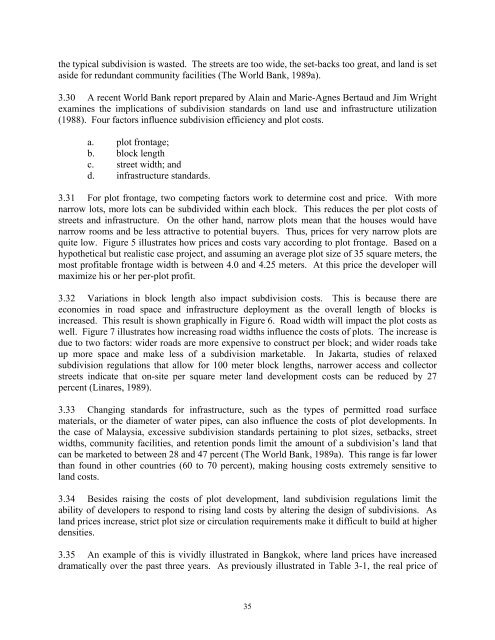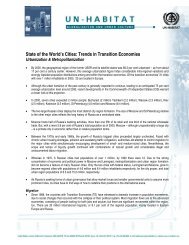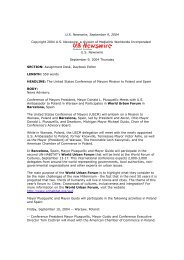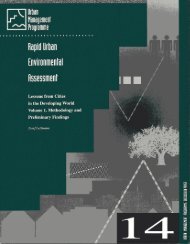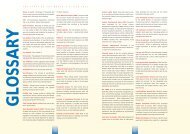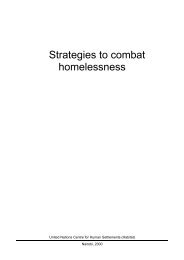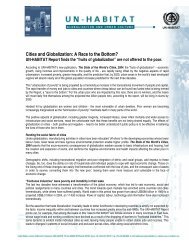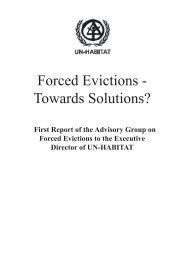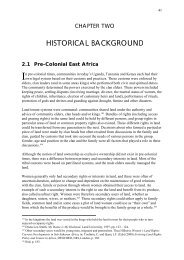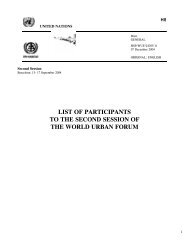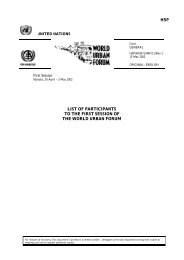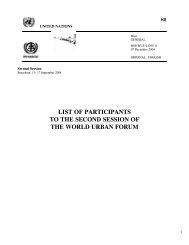a framework for reforming urban land policies in ... - UN-HABITAT
a framework for reforming urban land policies in ... - UN-HABITAT
a framework for reforming urban land policies in ... - UN-HABITAT
You also want an ePaper? Increase the reach of your titles
YUMPU automatically turns print PDFs into web optimized ePapers that Google loves.
the typical subdivision is wasted. The streets are too wide, the set-backs too great, and <strong>land</strong> is set<br />
aside <strong>for</strong> redundant community facilities (The World Bank, 1989a).<br />
3.30 A recent World Bank report prepared by Ala<strong>in</strong> and Marie-Agnes Bertaud and Jim Wright<br />
exam<strong>in</strong>es the implications of subdivision standards on <strong>land</strong> use and <strong>in</strong>frastructure utilization<br />
(1988). Four factors <strong>in</strong>fluence subdivision efficiency and plot costs.<br />
a. plot frontage;<br />
b. block length<br />
c. street width; and<br />
d. <strong>in</strong>frastructure standards.<br />
3.31 For plot frontage, two compet<strong>in</strong>g factors work to determ<strong>in</strong>e cost and price. With more<br />
narrow lots, more lots can be subdivided with<strong>in</strong> each block. This reduces the per plot costs of<br />
streets and <strong>in</strong>frastructure. On the other hand, narrow plots mean that the houses would have<br />
narrow rooms and be less attractive to potential buyers. Thus, prices <strong>for</strong> very narrow plots are<br />
quite low. Figure 5 illustrates how prices and costs vary accord<strong>in</strong>g to plot frontage. Based on a<br />
hypothetical but realistic case project, and assum<strong>in</strong>g an average plot size of 35 square meters, the<br />
most profitable frontage width is between 4.0 and 4.25 meters. At this price the developer will<br />
maximize his or her per-plot profit.<br />
3.32 Variations <strong>in</strong> block length also impact subdivision costs. This is because there are<br />
economies <strong>in</strong> road space and <strong>in</strong>frastructure deployment as the overall length of blocks is<br />
<strong>in</strong>creased. This result is shown graphically <strong>in</strong> Figure 6. Road width will impact the plot costs as<br />
well. Figure 7 illustrates how <strong>in</strong>creas<strong>in</strong>g road widths <strong>in</strong>fluence the costs of plots. The <strong>in</strong>crease is<br />
due to two factors: wider roads are more expensive to construct per block; and wider roads take<br />
up more space and make less of a subdivision marketable. In Jakarta, studies of relaxed<br />
subdivision regulations that allow <strong>for</strong> 100 meter block lengths, narrower access and collector<br />
streets <strong>in</strong>dicate that on-site per square meter <strong>land</strong> development costs can be reduced by 27<br />
percent (L<strong>in</strong>ares, 1989).<br />
3.33 Chang<strong>in</strong>g standards <strong>for</strong> <strong>in</strong>frastructure, such as the types of permitted road surface<br />
materials, or the diameter of water pipes, can also <strong>in</strong>fluence the costs of plot developments. In<br />
the case of Malaysia, excessive subdivision standards perta<strong>in</strong><strong>in</strong>g to plot sizes, setbacks, street<br />
widths, community facilities, and retention ponds limit the amount of a subdivision’s <strong>land</strong> that<br />
can be marketed to between 28 and 47 percent (The World Bank, 1989a). This range is far lower<br />
than found <strong>in</strong> other countries (60 to 70 percent), mak<strong>in</strong>g hous<strong>in</strong>g costs extremely sensitive to<br />
<strong>land</strong> costs.<br />
3.34 Besides rais<strong>in</strong>g the costs of plot development, <strong>land</strong> subdivision regulations limit the<br />
ability of developers to respond to ris<strong>in</strong>g <strong>land</strong> costs by alter<strong>in</strong>g the design of subdivisions. As<br />
<strong>land</strong> prices <strong>in</strong>crease, strict plot size or circulation requirements make it difficult to build at higher<br />
densities.<br />
3.35 An example of this is vividly illustrated <strong>in</strong> Bangkok, where <strong>land</strong> prices have <strong>in</strong>creased<br />
dramatically over the past three years. As previously illustrated <strong>in</strong> Table 3-1, the real price of<br />
35


